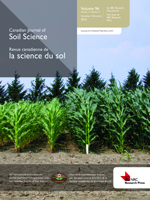Whitman, T., Yanni, S.F. and Whalen, J.K. 2011.Life cycle assessment of corn stover production for cellulosic ethanol in Quebec. Can. J. Soil Sci.91: 997-1012. The province of Quebec has a target of 5% ethanol (EtOH) content in fuel by 2012, which means the province will require about 400 million L of ethanol per year based on current consumption. Current research is focused on “second generation biofuels” such as cellulosic EtOH, which can be produced from agricultural by-products like corn stover. A life cycle assessment (LCA) evaluates the “cradle to gate” impact of corn stover feedstock production for cellulosic EtOH production in three corn-producing regions in Quebec for two impact categories: energy and greenhouse gas (GHG) impacts. The modelled system boundaries include in-field processes: corn stover production, collection, transport, soil organic carbon (SOC) loss, and N2O emissions, as well as background processes: herbicide, fertilizer, seed, and fuel production and transport. Sensitivity analyses vary the percentage of corn stover collected, contrast a multiple-pass with a one-pass stover-grain collection system, and compare mass, economic and system expansion allocation methods. Total energy impact is 931-1442 MJ t-1 dry stover collected under 15% stover collection, with stover harvest, transport, and field operationscontributing most strongly to the total impact. Total GHG emissions from corn stover production and transport of stover to the ethanol facility are320-488kg CO2e t-1 dry stover under 15% stover collection, with SOC loss, N2O emissions, and stover harvest contributing the most to the total impact. Sensitivity analysis reveals that the energy and GHG impacts of stover production are strongly influenced by the mass of stover collected, the use of a one-pass system, and the choice of allocation methods. Scaling-up results from the modelled system suggest that 100% of Quebec's EtOH targets could technically be supplied using corn stover feedstock, but this may come at the expense of GHG emissions and soil health.
How to translate text using browser tools
1 November 2011
Life cycle assessment of corn stover production for cellulosic ethanol in Quebec
Thea Whitman,
Sandra F. Yanni,
Joann K. Whalen
ACCESS THE FULL ARTICLE
It is not available for individual sale.
This article is only available to subscribers.
It is not available for individual sale.
It is not available for individual sale.
Agricultural feedstock
analyse du cycle de vie
biocarburant
biofuel
conservation de la matière organique du sol
environmental impact
impact sur l'environnement





